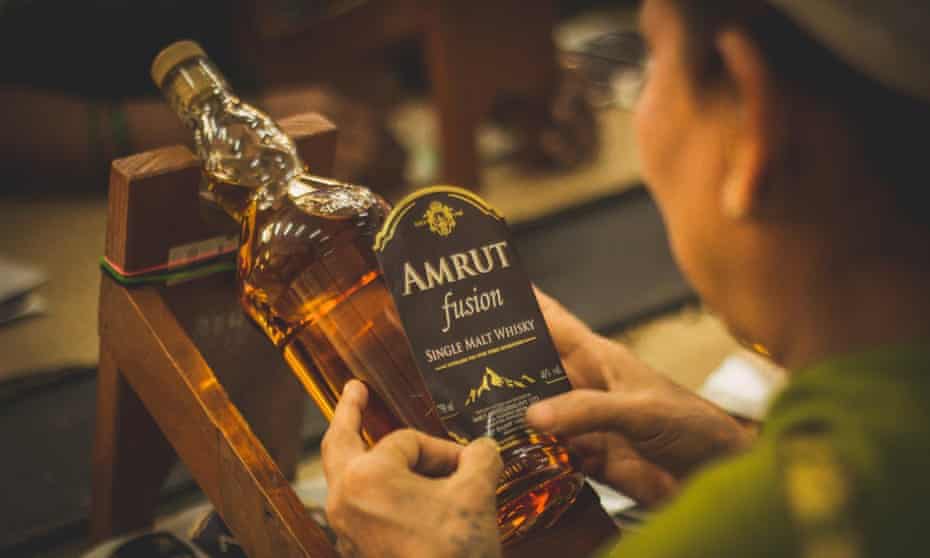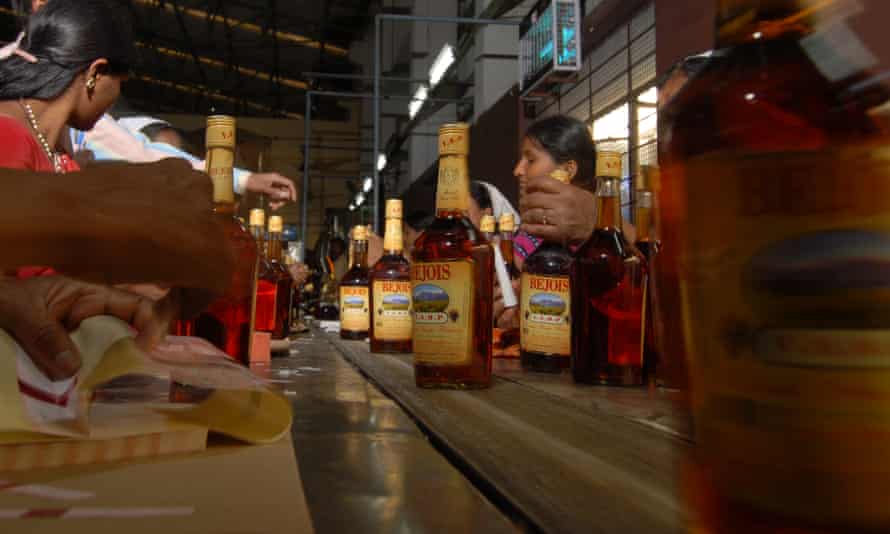Charu Sudan Kasturi

For years, Mohinder Singh’s trips outside India meant an obligatory stop at the airport duty-free liquor store, where he would join long queues to stock up on imported single-malt whisky. Then three years ago, he came across a brand – Paul John – that he had never heard of, at a tasting event a few miles from Delhi’s Jawaharlal Nehru University, where he teaches politics. It was an Indian single malt; its smoky smell was rich, the taste was even better. Singh was hooked.
“That was a gamechanger for me,” he says. Singh introduced his friends to the brand, which is now their drink of choice when they meet. “Everyone loves it.”
They are not alone. Drinkers in India, the world’s most lucrative whisky market – worth $18.8bn (£15bn) last year – have traditionally clinked glasses of blended whiskies or imported single malts. Now several Indian single malts that were launched internationally a few years ago – led by Paul John, Amrut and Rampur – are grabbing a major share of the domestic market. It is a seismic shift for the global whisky industry.
Vinod Giri, who heads the Confederation of Indian Alcoholic Beverage Companies (CIABC), says homegrown single malts constitute 33% of the market in India, up from 15% five years ago. That figure is poised for an even more rapid rise: sales have surged by an average annual rate of 42% over the past three years, compared with just 7% for imported rivals, according to CIABC data.
This trend has caught the attention of global firms too. Diageo, the world’s second-biggest alcohol company by valuation and headquartered in London, launched an Indian-made single malt in March called Godawan. “Global giants are recognising the demand for homegrown single malts in India,” says Sanjeev Banga, an executive at Radico Khaitan, the makers of Rampur. “What bigger endorsement could there be?
That “endorsement” comes two decades after the European Union refused to even recognise Indian whisky. Historically, India grappled with shortages of grain, but it produced lots of sugarcane, so liquor companies such as Amrut, which was founded in 1948, relied on spirits derived from molasses. The EU, however, said that meant that what India claimed to be whisky was actually rum.
Now India is one of the world’s largest producers of wheat. In 2004, Amrut launched India’s first single malt in Glasgow, before expanding across Europe. It entered the Indian market in 2010. Paul John took a similar route – introducing its single malt in the UK in 2012, and then to Indian consumers in 2013. Rampur joined them in 2015. Indri Trini, a new Indian single malt from the northern state of Haryana, was launched last year and has already won international awards.
“Only the crème de la crème of Indian society was familiar with single malts until recently, and it only knew and trusted foreign whisky,” says Pramod Kashyap, Amrut’s head of international operations, explaining why Indian brands were more confident about launching their whiskies globally than they were about their home market.
However, their gamble on Indian consumers has paid off handsomely as India’s whisky drinkers’ tastes have evolved.
A new generation has grown up without the colonially ingrained assumption that imported goods are superior to Indian products, says Giri. “They go by their judgment of quality rather than origin of the product,” he says. “There is in fact a reverse underlying notion of Indian products being at par or even better than global products.”
Indian whiskies also offer unique tastes, says Devaki Rajagopalan, a Bengaluru-based marketing executive. Her favourite is Amrut Amalgam, which marries the fruity flavours of nectarine, melon and pears with the smokiness of peat and the sharp punch of Indian black pepper. “I’ve tried whiskies around the world and I’ve never had an aftertaste that lingers so powerfully,” she says.
Her father, she says, only drank blended whiskies and was reluctant to change, but the subtle infusion of Indian tastes – such as the pepper in Amrut Amalgam – converted him.
It is not just what is added that makes the flavours different, though, says Giri. India’s hot and humid weather plays a critical role too, ageing whisky faster than Scotland’s cooler climate. “Such rapid ageing lends some unique taste profile and texture to Indian single malts,” he says.
The rise of Indian whisky-makers has led to the emergence of enthusiasts who meet for tasting sessions and review new offerings.
 Production at the Amrut distillery in Bengaluru. Photograph: Mint/Hindustan Times/Getty
Production at the Amrut distillery in Bengaluru. Photograph: Mint/Hindustan Times/GettyIt was at one such session, organised by Bengaluru’s Single Malt Amateur Club, that Rajagopalan first tried Amrut two years ago. After seeing the club’s online review of Amrut Neidhal – a new limited-edition whisky described as having notes of sea salt, orange peel and the smell of coastal peat – last November, she rushed to get a bottle. In her Tamil language, Neidhal means a coastal town. “These little associations make it a personal, warm experience,” she says.
Breaking with the elitism often associated with single malts in India, reviewers are appraising homegrown whiskies in local languages, as well as English, reaching new audiences.
When you get a single malt that’s as good or better, at less than half the price, it’s an offer you can’t refuse
Their relatively low price compared with imported whisky have also helped Indian brands. In his Delhi suburb of Gurgaon, Singh can buy a bottle of Paul John for about £22, while Amrut Amalgam costs £28. India imposes a 150% tariff on imported whiskies, so Glenmorangie costs £67.
“Indian consumers of single malt never had a top-quality alternative to imported whiskies,” says Singh. “When you get a single malt that’s as good or better, at less than half the price, it’s an offer you can’t refuse.”
In 2020, the Indian government banned foreign spirits at the country’s 4,000-odd stores for the armed forces, creating a captive market, says Giri. Also, the disruption of global supply chains by the coronavirus pandemic exposed many Indian drinkers to local whiskies for the first time, he says. “Once consumers found them matching their expectations, they stayed.”
All of this has combined to create an explosion in local demand that Indian manufacturers had not planned for. Amrut produced 350,000 litres of single malt in 2019; today it distils 1m litres, says Kashyap. Some of Rampur’s offerings are sold out and Radico Khaitan is struggling to meet demand, says Banga. “We just don’t have the capacity to produce what we know we can sell. We hope to get there in a couple of years, and I promise you, you’ll see a lot more Rampur on shelves.”
That might depend on how Indian single malts is served by the free trade agreement Delhi is negotiating with London. When Boris Johnson was foreign secretary, he described bringing a bottle of scotch when he visited the family of his half-Indian former wife Marina Wheeler so they could avoid the high import tariffs. “This is the time to tear these barriers down,” he said.
But dramatic cuts in tariffs, as the UK wants, “could give us a bloody nose”, says Kashyap. A free trade agreement could be troubling for Indian manufacturers if Britain continues to insist that whisky must be aged for at least three years in wooden casks, says Giri. In India’s climate, that would evaporate 30% of the whisky, he says, pushing costs up to an “unviable level”, with the result that Indian whiskies would not get the access to British markets that UK single malts have in India.
Nevertheless, Banga says he is confident that Indian single malts can weather competition from imports, even if they are priced similarly. “Remember, we’ve competed with them abroad,” he says.
For whisky drinkers such as Singh and Rajagopalan, there is no turning back. On a forthcoming trip to Goa with her father, Rajagopalan wants to visit Paul John’s distillery. “It’s exciting – the trip almost feels like a pilgrimage,” she says.
… as you’re joining us today from India, we have a small favour to ask. Tens of millions have placed their trust in the Guardian’s fearless journalism since we started publishing 200 years ago, turning to us in moments of crisis, uncertainty, solidarity and hope. More than 1.5 million supporters, from 180 countries, now power us financially – keeping us open to all, and fiercely independent.
Unlike many others, the Guardian has no shareholders and no billionaire owner. Just the determination and passion to deliver high-impact global reporting, always free from commercial or political influence. Reporting like this is vital for democracy, for fairness and to demand better from the powerful.
And we provide all this for free, for everyone to read. We do this because we believe in information equality. Greater numbers of people can keep track of the global events shaping our world, understand their impact on people and communities, and become inspired to take meaningful action. Millions can benefit from open access to quality, truthful news, regardless of their ability to pay for it.
If there were ever a time to join us, it is now. Every contribution, however big or small, powers our journalism and sustains our future.
No comments:
Post a Comment